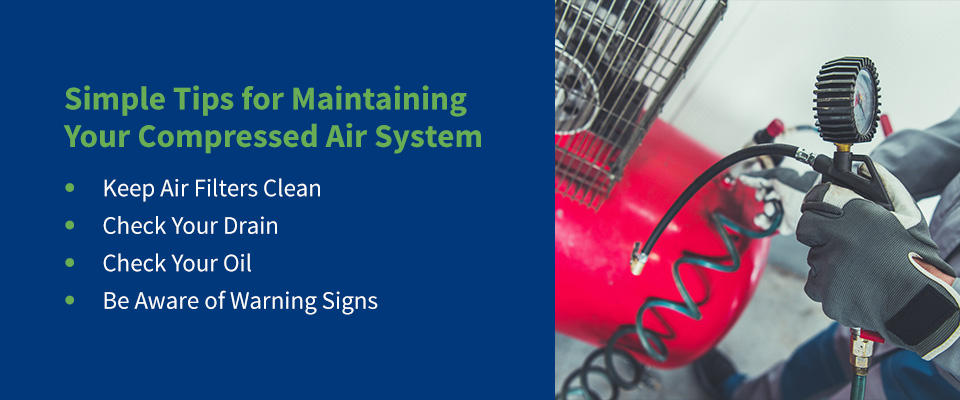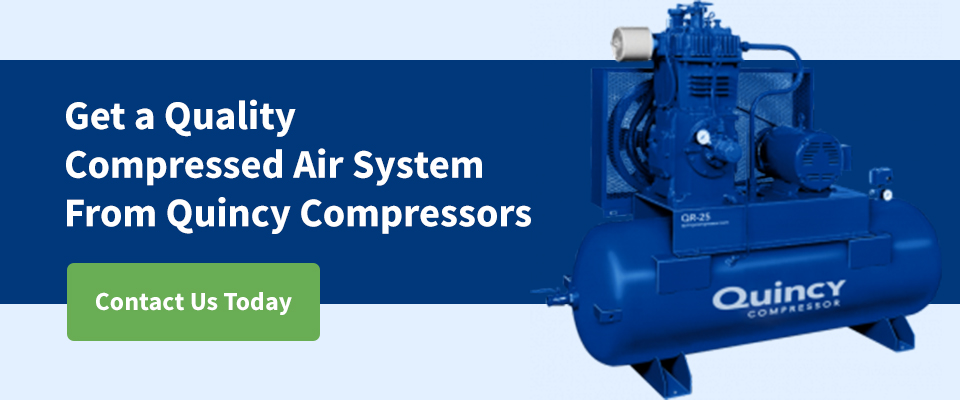
Compressed air is so common in industrial applications that many people consider it a utility in the same way they view water and natural gas. Compressed air systems are valuable resources for powering a facility’s machinery and tools and performing other essential tasks.
If you need to add the power of air to your operation, a compressed air system will provide the capability and utility you need to drive pneumatic tools and other resources. In this introduction to compressed air systems, we’ll explore the basics of these reliable solutions.
What Is a Compressed Air System?
An air compressor system is a network of equipment that captures and distributes pressurized air to operate machinery and devices such as automated valves, slide gates and diverters. This technology stores air at high pressure by forcing the molecules into a smaller space, then releases it on an operator’s command or at a set time. The pressurized air can then be used to power tools, clean off workpieces, fill receptacles and serve other applications. With compressed air energy storage systems (CAES), it can even be used as a form of renewable energy.
The air compressor, the heart of the system, is the mechanical device that pressurizes the air. An electric motor will usually run the compressor either when the storage tank reaches a sufficiently low pressure or when an operator manually engages it. Compressed air systems operate on two different kinds of air displacement compressor technologies:
- Positive displacement: This method physically forces air into a confined space by reducing its volume with the help of the specific movement of a mechanical device.
- Dynamic displacement: The dynamic displacement compressor speeds the air up to a high velocity, allowing the energy created by this process to build up the air pressure.
Compressed Air System Components
A compressed air system is much more than just an air compressor. A basic compressed air system is made up of the following components:
- The Air Intake Filter is a device composed of fibrous materials designed to trap atmospheric airborne particles such as dust, pollen and mold before they can reach the compressor.
- The Air Compressor is a machine used to convert power (usually from an electric motor, a diesel engine or a gasoline engine) into kinetic energy by compressing and pressurizing air, which the air compressor can release in quick bursts on command. There are several different types of air compressors, including reciprocating, rotary screw and rotary centrifugal.
- The Aftercooler cools the system lubricant and discharged air.
- The Air Receivers provide compressed air storage capacity to meet peak demand events and help control system pressure by controlling the rate of pressure change in the system.
- The Air Dryer removes condensation from compressed air in order to prevent damage to the system.
Compressed air systems can last 10 to 15 years on average. The top two causes of premature system failure are improper installation and improper maintenance.
Simple Tips for Maintaining Your Compressed Air System
It is recommended that your compressed air system be professionally serviced at least annually.
Keep Air Filters Clean
Air compressors will continue to work at their best when you clean them regularly. Keeping air filters clean can lower your compressed air system’s electricity use by 5 – 15%. Neglecting to do so can result in clogged filters, which may cause a drop in pressure and force the compressor to work harder. As a rule of thumb, it’s best to change your filter every three to six months and ensure that the filtration system receives regular inspections.
Check Your Drain
Check your drain traps to make sure these contaminant removal devices have properly functioning drains and clear lines to handle the constant airflow. To maintain your compressed air system’s drains, it’s important to treat condensate before releasing it into the drain since it may contain compressor oil. That said, you’ll also need to ensure your treatment units are working and have a replacement service kit to reduce downtime during maintenance.
Check Your Oil
Just like a car, your air compressor needs regular oil changes or you risk destroying the engine. It’s therefore essential to check the oil levels of your air compressor regularly and add more when necessary. When performing these checks, it’s also wise to inspect the system for any oil leaks so you can catch them early on and perform any necessary repairs. It’s best to change the oil and oil filters at the manufacturer’s recommended intervals to maintain their quality.
Be Aware of Warning Signs
Stay alert for warning signs such as unusual noises, overheating, excessive vibrations or belt slippage. If your compressed air system is louder than usual, it may be suffering from loose parts, poor mounting, pistons hitting the valve plate or a crankcase issue.
Whatever the case, your compressed air system needs regular maintenance to avoid problems and ensure it can perform as intended. Similarly, if you notice overheating, frequent tripping, oily discharge or loss of pressure, it may be time to schedule planned maintenance with a professional.
Last Updated on September 20, 2023 at 12:30 PM



